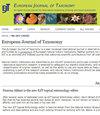Diversity and taxonomy of the Late Triassic sauropodomorphs (Saurischia, Sauropodomorpha) stored in the Palaeontological Collection of Tübingen, Germany, historically referred to Plateosaurus
IF 1.3
3区 生物学
Q3 ENTOMOLOGY
引用次数: 0
Abstract
The genus Plateosaurus is one of the most challenging aspects of early-diverging sauropodomorph taxonomy, with a total of 29 names and a century of revisions. As a result, nomina dubia have been treated as synonyms of Plateosaurus trossingensis, adding to the confusion about the extent of morphological variability. Here, we provide a thorough revision of the taxonomy proposed by von Huene as well as the subsequent taxonomic interpretations of Plateosaurus through a complete inventory of the specimens stored in the Palaeontological Collection of Tübingen. We reassess the status of the specimens in the collection and propose that the sauropodomorph-bearing layers are not necessarily monospecific. Most of the original fieldwork documentation has been lost, but we use the taxonomy established by von Huene as a historical reference point to reconstruct what was known at the time. This revised taxonomy of Plateosaurus narrows the genus to three species: Pl. trossingensis, Pl. longiceps, and Pl. gracilis (as a metataxon), and restricts the genera Gresslyosaurus and Pachysaurus to large and robust individuals, as pragmatic decisions aimed to test their affinities to other Late Triassic sauropodomorphs. Future studies should consider not only morphological variability, but also stratigraphy, palaeogeography, and environmental data when delineating species within and outside the Plateosaurus plexus.德国图宾根古生物收藏馆收藏的三叠纪晚期蜥脚类(金牛目,蜥脚类)的多样性和分类法,历史上曾被称为板龙
板龙属(Plateosaurus)是早期分化的蜥脚类动物分类学中最具挑战性的一个方面,该属共有 29 个名称,历经了一个世纪的修订。因此,一些不知名的名称被当作特罗辛格板龙(Plateosaurus trossingensis)的同义词,从而加剧了形态变异程度的混乱。在这里,我们通过对图宾根古生物收藏馆所藏标本的完整清点,对冯-胡内(von Huene)提出的分类法以及随后对板龙的分类解释进行了彻底的修订。我们重新评估了收藏馆中标本的地位,并提出含蜥脚类恐龙的地层不一定是单种的。大部分原始的野外工作文献已经遗失,但我们将 von Huene 确立的分类法作为历史参考点,重建了当时已知的分类法。修订后的板龙分类法将板龙属缩减为三个物种:trossingensis、Pl. longiceps和Pl. gracilis(作为一个中统),并将Gresslyosaurus属和Pachysaurus属限制为大型和健壮的个体,这些务实的决定旨在检验它们与其他晚三叠世的剑龙类的亲缘关系。未来的研究在划分板龙系内外的物种时,不仅要考虑形态学的变异性,还要考虑地层学、古地理学和环境数据。
本文章由计算机程序翻译,如有差异,请以英文原文为准。
求助全文
约1分钟内获得全文
求助全文
来源期刊

European journal of taxonomy
ZOOLOGY-
CiteScore
2.30
自引率
8.30%
发文量
173
审稿时长
29 weeks
期刊介绍:
EJT is a fully refereed, international, fully electronic Open Access journal in descriptive taxonomy, covering subjects in zoology, entomology, botany (in its broadest sense), and palaeontology. EJT-papers must be original and adhere to high scientific (content) and technical (language, artwork, etc.) standards. Manuscripts that are clearly substandard in either of these categories will not be sent out for review. EJT is supported by a consortium of European Natural History Institutes, but its scope is global. Both authorship and geographical region of study need not be European. Authors are, however, strongly encouraged to involve European Natural History collections by consulting material or by depositing specimens (e.g. types and figured material) related to their published paper in the collection of a European Natural History Institute.
 求助内容:
求助内容: 应助结果提醒方式:
应助结果提醒方式:


